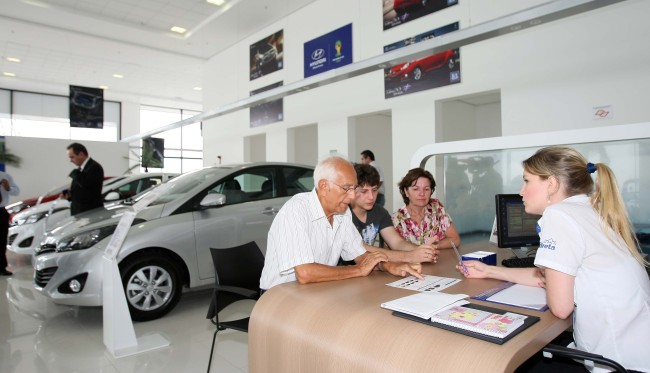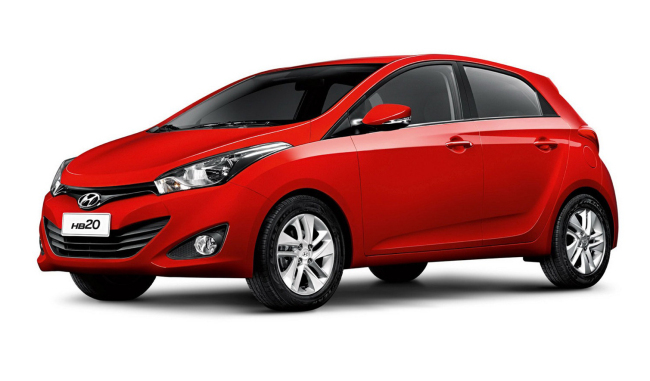SAO PAULO ― In a country long dominated by the world’s auto giants, Hyundai Motor Brazil saw a golden opportunity in Latin America’s biggest auto market and seized its chance.
For the past three years, it has shaken up the compact segment by giving drivers of “popular cars” the high-end treatment.
Thanks to the self-transformation of its brand image as a car for the common driver, Hyundai is one of the six most sought-after car brands in the country. And even producing 180,000 cars a year at full capacity, Hyundai Motor Brazil, a local subsidiary of Korea’s Hyundai Motor Group, can barely keep up with demand in the biggest auto market in Latin America, company officials say.
“The customers’ perception of Hyundai products is very high. A Hyundai brand in Brazil is classified as a premium brand,” said Eugenio Cesare, director of production at Hyundai Motor Brazil in Sao Paulo. “Because our products’ innovation, comfort and features attended fully to what the market was demanding, we have this fast-growing operation in Brazil. We fully attended to what the customer was expecting.”
For the past three years, it has shaken up the compact segment by giving drivers of “popular cars” the high-end treatment.
Thanks to the self-transformation of its brand image as a car for the common driver, Hyundai is one of the six most sought-after car brands in the country. And even producing 180,000 cars a year at full capacity, Hyundai Motor Brazil, a local subsidiary of Korea’s Hyundai Motor Group, can barely keep up with demand in the biggest auto market in Latin America, company officials say.
“The customers’ perception of Hyundai products is very high. A Hyundai brand in Brazil is classified as a premium brand,” said Eugenio Cesare, director of production at Hyundai Motor Brazil in Sao Paulo. “Because our products’ innovation, comfort and features attended fully to what the market was demanding, we have this fast-growing operation in Brazil. We fully attended to what the customer was expecting.”

Hyundai Motor Brazil owes its success to ramped-up marketing and its compact model that became a game changer in the industry: The HB20, whose comfort items and chic design won over 81,000 customers in Brazil in the first half of the year, reaching 5.1 percent of the entire market.
Success of the HB20
Before the HB20 launched in 2012, Brazilian car experts note, Hyundai appeared out of reach to ordinary Brazilians: Models like the ix35 and i30 stood alongside premium Toyotas and Hondas as pricey import cars to be admired from afar.
But with Brazil’s Big Four ― Volkswagen, Fiat, GM and Ford ― idly dominating some 80 percent of the local industry for decades, Hyundai spotted a quickly growing niche, the so-called “popular” segment. People with rising incomes began to want new, trendy cars of their own, according to Carlos Roberto, sales manager of the Grand Brasil Barra Funda dealership in Sao Paulo.
“When (Hyundai) came to Brazil, it was not a saturated market, but it was a market looking for innovations,” said Roberto. “So a car with a more modern design conquered this public, and also made other automakers improve their cars and launch cars with a nicer design.”
Hyundai ramped up its local marketing campaign even between 2007 and 2009, when others were tapering their budgets in the face of an economic downturn. And as a consequence, Hyundai saw a 35 percent on-year jump in market share, according to a report by Havas, a media analysis company.
The HB20, priced at 34,995 reais to 58,140 reais ($15,750-$26,000) and produced exclusively for Brazil’s design-crazy drivers, burst into the compact market ― which accounts for 65-70 percent of local car sales ― with a sleek exterior, narrow nose and modern display that provided a fresh look among its competitors’ “simple, old” designs, a Hyundai official noted. But what rattled its rivals was the premium approach to its basic model, which included air conditioning, antilock brakes and hydraulic steering, not to mention a five-year warranty and trusty customer service, for the first time in the young, high-potential market.
Demand flurried in an HB20 “fever” as the high-end brand suddenly became accessible not only to the rich, but also to middle and lower-class buyers, according to Bruno Bonini, who was a sales management consultant to Volkswagen do Brasil at the time.
“There was the ix35 and i30 and they are really desired cars, and the HB20 was like a small version of those,” he said. “Everybody (wanted) that car.”
Mauricio Jordao, communications chief for Hyundai Motor Brazil, said that offering the same brand and quality level, plus comfort items at an affordable price led to a huge increase in brand perception.
“When we launched the HB20, it took almost six months to get the car. That was quite impressive, because everyone was admiring the brand but could not afford (it),” he said. “When we got the HB20 with a very competitive price, then it was an affordable car.”
The HB20, the only model produced in Hyundai’s factory in Sao Paulo, now comes as a 1.0-liter and 1.6-liter engine sedan, hatchback and crossover in six colors.
Andre Lawson, an engineer in Rio de Janeiro, said he had to wait a month to buy an HB20, his first Hyundai, in December 2012 after reading positive reviews and talking to fellow Hyundai owners.
“Before I bought my car, my impressions of the brand came mostly from my father, who owned an i30, and are pretty much the same as I have now: Good-quality cars and better value when compared to other brands,” he said, adding that he has found his car to be comfortable and reliable for his typical weekend travel needs.
“My opinion, which I believe is also the general perception in Brazil, is that Hyundai offers good-quality cars, very well equipped and within a lower price range than other brands.”
The popularity of the HB20 has pushed Hyundai from the ninth to sixth best-selling brand in the country’s overall auto market, noted Jordao. “HB20” was the most-searched auto term for Google Zeitgeist 2013, a year when the model saw more than 111,000 new vehicle registrations.
Expanding the customer base
Nowadays, it’s impossible not to know Hyundai here, especially in major cities after it was the official automotive sponsor for the FIFA World Cup ― with every team bus, plus 1,000 Hyundai cars and 400 from its sister company Kia being supplied for the games in June and July.
Posters of veteran Brazilian footballer Kaka and rising midfielder Oscar are plastered on Hyundai billboards near Fan Fest areas, where people gather to watch matches on mega screens. Airports carry giant TVs with posters and signs with famous players sporting Hyundai jerseys next to slick white Santa Fe crossovers.
The special World Cup edition HB20s with leather seats, a TV and a World Cup logo on the side have nearly sold out, with 7,000 of 8,000 having left dealerships across the country, according to company officials.
“Open any magazine here, you can see Hyundai advertising here all the time,” said Glenn Di Fiore, a Central Bank worker in Porto Alegre who owns a Santa Fe, his second Hyundai vehicle. “It’s a new brand here in Brazil, but I think Brazilians already trust Hyundai. It has been here long enough to prove itself to be reliable.”
He said Hyundai’s marketing as well as dependable after-sales service had been effective in gaining the trust of everyday Brazilians in the past few years.
“If you need a spare part, you don’t have to wait too long,” he added. “They won’t leave you unassisted.”
The efforts have paid off, company officials noted, as Hyundai Motors Brazil earned the No. 3 ranking in J.D. Power’s annual customer satisfaction survey in May, behind No. 2 Toyota and leader Hyundai-CAOA, which imports all Hyundai models outside of the locally produced HB20.

The HB20 was the first model not made by the Big Four to reach the top six bestsellers, as 43,800 units were sold in the first quarter last year, according to a report by Fenabrave, the national car dealer association. Even when all other cars’ sales fell in a turbulent first quarter this year, only Hyundai and Renault stayed afloat with on-year gains, Fenabrave said.
Now second-tier carmakers such as Hyundai have strong potential for growth, with the HB20 even threatening the No. 4 spot in sales.
“Smaller players still have, with such a high growth forecast, real opportunity to increase sales volume in the coming years,” the Havas Media report said. “Small brands like Hyundai are making strong year-on-year gains.”
Hyundai officials said they expect the compact segment will continue to grow, especially as people are exchanging bigger cars with higher fuel consumption for more compact, economical models.
With operations at full capacity, the company is focusing on developing its dealership networks, clearing production bottlenecks and improving its products’ quality rather than volume of production, said Jordao, the communications chief.
“The situation today is stable. We have a nice factory, we operate three shifts, we have a nice, very competitive product, and we are among the five or six biggest brands in Brazil from a sales volume perspective. So we are very satisfied with the result at this moment,” he said,
He noted that Hyundai’s production growth would slow down from 14-15 percent to less than 5 percent to stabilize in the short term, and expected the Brazil operation to follow suit.
“The focus will be on quality growth more than volume growth for the coming years,” he said, noting that the factory in Sao Paulo celebrates its second anniversary in November. “(We’ll have) a lot of things to celebrate,” he added.
By Elaine Ramirez, Korea Herald correspondent
(elaine@heraldcorp.com)
Dina Perez in Seoul contributed to this article. ― Ed.
-
Articles by Korea Herald








![[Kim Seong-kon] Democracy and the future of South Korea](http://res.heraldm.com/phpwas/restmb_idxmake.php?idx=644&simg=/content/image/2024/04/16/20240416050802_0.jpg&u=)








![[KH Explains] Hyundai's full hybrid edge to pay off amid slow transition to pure EVs](http://res.heraldm.com/phpwas/restmb_idxmake.php?idx=652&simg=/content/image/2024/04/18/20240418050645_0.jpg&u=20240418181020)

![[Today’s K-pop] Zico drops snippet of collaboration with Jennie](http://res.heraldm.com/phpwas/restmb_idxmake.php?idx=642&simg=/content/image/2024/04/18/20240418050702_0.jpg&u=)